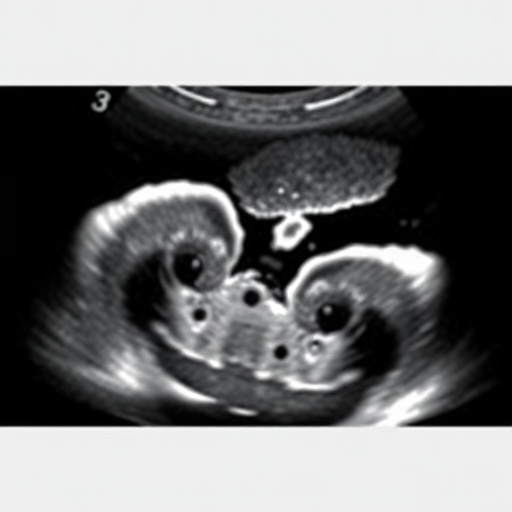A groundbreaking study conducted by Prasad and colleagues has brought new insights into the determination of gestational age in neonates, leveraging the power of transcerebellar ultrasound measurements. As neonatal care continues to evolve with technological advancements, the ability to assess the precise gestational age of newborns is crucial for ensuring adequate medical attention and interventions. The study, which examines a sizable cohort of 671 neonates, reveals the potential for improved accuracy in gestational age assessment, significantly impacting neonatal outcomes.
Gestational age plays a vital role in the treatment and management of newborns, influencing decisions regarding care protocols and interventions. Traditionally, gestational age has been determined using obstetric estimates, which may not always reflect the actual developmental stage of the infant. Challenges arise particularly in preterm or low-birth-weight infants where deviations from expected growth can lead to misclassification and subsequent management errors. The innovative application of transcerebellar ultrasound measurements aims to address these challenges.
The transcerebellar measurement technique, which involves assessing the size of the cerebellum through ultrasound, has emerged as a reliable indicator of developmental progress. This study highlights its efficacy, noting how the cerebellum’s growth patterns correlate closely with gestational age, providing clinicians with a more objective criterion than traditional methods. Ultrasound imaging is non-invasive and presents no risk to the infant, further enhancing its viability as a standard practice in neonatal care.
In conducting their research, the team employed a retrospective study design, analyzing data from 671 neonates. This method allowed for a comprehensive examination of cases across different gestational age ranges. By comparing the traditional gestational age assessments with those derived from transcerebellar measurements, the researchers aimed to quantify the accuracy of this novel technique. The outcomes reveal that transcerebellar ultrasound can potentially bridge the gap in gestational age determination, particularly where traditional assessments fall short.
One of the most notable findings of the study is the evident variance in gestational age determination when using transcerebellar measurements versus conventional methods. This variance underscores the importance of incorporating advanced imaging techniques into routine neonatal assessments. The potential to enhance the accuracy of gestational age identification can lead to more tailored care protocols, addressing the specific needs of neonates based on their developmental stage.
Moreover, improving gestational age assessment has broader implications for neonatal health outcomes. Infants born prematurely or with developmental concerns are at a heightened risk for complications, including respiratory distress and developmental delays. Accurate determination of gestational age enables healthcare providers to initiate appropriate interventions timely and effectively, thereby optimizing care and improving survival chances.
Healthcare practitioners are increasingly recognizing the value of this innovative approach in their clinical practices. Early detection and intervention are pivotal in neonatal medicine, and transcerebellar ultrasound measurements promise to refine these processes. The research advocates for the adoption of this technique on a wider scale within neonatal intensive care units (NICUs), emphasizing the need for training clinicians in its application.
As neonatology continues to embrace technological advancements, the integration of transcerebellar ultrasound can transform the landscape of neonatal care. By implementing evidence-based practices rooted in this research, healthcare systems can foster an environment of enhanced accuracy and improved outcomes for our most vulnerable patients. This study not only reinforces the significance of ultrasound in clinical practice but also advocates for continual research and innovation in neonatal assessments.
With this research slated for publication in the esteemed journal, Pediatric Radiology, the authors hope to stimulate further discussion and exploration in the field of neonatal imaging. As the medical community diligently strives for excellence in neonatal care, the integration of advanced imaging techniques like transcerebellar ultrasound serves as a testament to the ongoing evolution of medical practices tailored to infant health.
In conclusion, the retrospective study on transcerebellar ultrasound measurements offers a promising avenue for enhancing the accuracy of gestational age determination in neonates. By improving the precision of assessments, the study paves the way for better-informed clinical decisions that can significantly impact neonatal care. As we anticipate the release of this impactful research, it stands as a reminder of the importance of innovation in the field of neonatal medicine and the potential to change lives through informed practices.
This research not only highlights the importance of accurate gestational age assessment but also sets a precedent for future studies aimed at refining existing methodologies. In a field where every moment counts, the ability to ascertain developmental stages rapidly and accurately holds the key to improving neonatal health outcomes. The evolving landscape of neonatal care is bright, propelled by studies that challenge the status quo and introduce novel solutions.
Subject of Research: Gestational Age Determination in Neonates
Article Title: Gestational age determination in neonates – transcerebellar ultrasound measurements help: a retrospective study of 671 neonates.
Article References:
Prasad, P., Cohen, H., Jo, M. et al. Gestational age determination in neonates – transcerebellar ultrasound measurements help: a retrospective study of 671 neonates.
Pediatr Radiol (2025). https://doi.org/10.1007/s00247-025-06426-9
Image Credits: AI Generated
DOI: 10.1007/s00247-025-06426-9
Keywords: Neonates, Gestational Age, Transcerebellar Ultrasound, Imaging Techniques, Neonatal Care.




